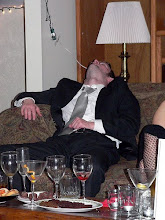 |
| fig. 1: James Bond |
Stop me if you've heard this one: a man--a renowned card sharp--engages in a high-stakes battle of wits with a fellow player at a faraway European casino. The card game is a bit of realpolitik. The man's opponent, who goes only by the name Le Chiffre has embezzled funds from his organization, and needs to gamble them back. If the man, James Bond, can successfully bankrupt Le Chiffre, than Le Chiffre's organization will be humiliated, and down a man.
Though it seems unthinkable now, the first James Bond was portrayed by an American, Barry Nelson. He portrays the character with an avuncular affability, to where I got the sense he'd be slightly more at home out of that tuxedo and in a polo shirt, mowing his lawn. Nelson really only seems to come in to his own at teh climax of the picture, when Bond is held by Le Chiffre and tortured. He seethes with pain and defiant rage in a way that makes you say "Oh, there you are."
 |
| fig. 2: It's not really made clear, but it seems as though they're pulling off his toenails. |
The rest of the roles are familiar: Le Chiffre is portrayed here by Peter Lorre in just the manner you'd expect. Felix Leiter, in response to Bond's being made American, is now an English secret agent named Clarence Leiter. Vesper Lynd and Mathis have been conflated into a character named Valerie Mathis, an old flame of Bond's who is a double-agent within Le Chiffre's ranks.
If the James Bond series can be read as an extended meditation on Western masculinity, than the contrast between Nelson and his successors is telling in how those portrayals differ between the US and the UK. Connery's interpretation of the character is much closer to the books, and his chilly remove distinguishes him from Nelson's Regular Joe. It's only later in the film that Nelson's Bond is shown as a Verified Secret Agent. In those first few scenes it's easy to imagine him simply as someone who won World Series of Baccarat and got recruited to clean out Le Chiffre. Nelson's character isn't portrayed particularly as a womanizer either, though that could be a reflection of the fact that Casino Royale only had an hour to tell its story, but he seems pretty hung up on Valerie through the course of the film, and their romance and reconnection is a major through-line. The silver-screen incarnation of James Bond is always held at a remove, be it Connery's chilliness or Moore's ironic distance. Nelson is much more American. His high competence as a card sharp and secret agent doesn't separate him from anyone. He's just a guy who's good at his job.
 |
| fig. 3: *shrugs* |
The "Casino Royale" telemovie was broadcast on October 21, 1954, as part of Climax!, a TV anthology series. The novel had been out a little over a year, and while it sold quite well in the UK, it didn't do so well in America. The telemovie features an introduction by host William Lundigan and a focus on the mechanics of the game of baccarat, as the game has never been particularly popular in America. I learned more about how baccarat is supposed to work here, as Bond and Leiter carry out a conversation on it for the benefit of prying ears, than I did all through the later James Bond films.
In contrast to the later globe-trotting incarnations of the character, Bond here is confined to a handful of sets: the casino floor, the hallway outside his hotel room, and the room itself. "Casino Royale" was a live TV broadcast, essentially James Bond: The Stage Play, so these sets are more perfunctory than in aid of any sort of claustrophobic feeling. Much like the book, it failed to set the world on fire here in the States, and none of Fleming's succeeding novels would be adapted again in the following eight years before Dr No. "Casino Royale" remains an interesting footnote, but barely that. It's like an echo in reverse, a premonition of what was to come.




No comments:
Post a Comment